

Step 2.1: Create a Deployment Package - AWS Lambda. From the Filter View list, choose the language you want to use for your Lambda function.
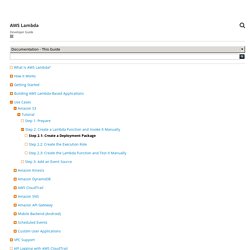
The appropriate section appears with code and specific instructions for creating a deployment package. The following is example Java code that reads incoming Amazon S3 events and creates a thumbnail. Note that it implements the RequestHandler interface provided in the aws-lambda-java-core library. Therefore, at the time you create a Lambda function you specify the class as the handler (that is, example.S3EventProcessorCreateThumbnail). For more information about using interfaces to provide a handler, see Leveraging Predefined Interfaces for Creating Handler (Java). The S3Event type that the handler uses as the input type is one of the predefined classes in the aws-lambda-java-events library that provides methods for you to easily read information from the incoming Amazon S3 event.
Requests 2.10.0. Python HTTP for Humans.
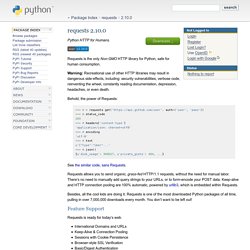
Requests is the only Non-GMO HTTP library for Python, safe for human consumption. Warning: Recreational use of other HTTP libraries may result in dangerous side-effects, including: security vulnerabilities, verbose code, reinventing the wheel, constantly reading documentation, depression, headaches, or even death. Behold, the power of Requests: See the similar code, sans Requests. Requests allows you to send organic, grass-fed HTTP/1.1 requests, without the need for manual labor. Besides, all the cool kids are doing it. Feature Support Requests is ready for today’s web. International Domains and URLsKeep-Alive & Connection PoolingSessions with Cookie PersistenceBrowser-style SSL VerificationBasic/Digest AuthenticationElegant Key/Value CookiesAutomatic DecompressionAutomatic Content DecodingUnicode Response BodiesMultipart File UploadsHTTP(S) Proxy SupportConnection TimeoutsStreaming Downloads.netrc SupportChunked RequestsThread-safety Installation How to Contribute.
Creating a Deployment Package (Python) - AWS Lambda. Creating a Deployment Package (Python) - AWS Lambda. To create a Lambda function you first create a Lambda function deployment package, a .zip file consisting of your code and any dependencies.
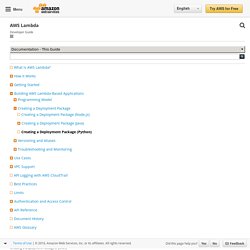
You can create a deployment package yourself or write your code directly in the Lambda console, in which case the console creates the deployment package for you and uploads it, creating your Lambda function. Note the following to determine if you can use the console to create your Lambda function: Simple scenario – If your custom code requires only the AWS SDK library, then you can use the inline editor in the AWS Lambda console. GitHub - sportarchive/aws-lambda-python-local: Run and Test locally, Dist and Deploy online your AWS Lambda Python functions with a simple Makefile. Deploy, Stage and Test you API Gateway calls too! Deploying a Flask Application to AWS Elastic Beanstalk - AWS Elastic Beanstalk. This tutorial walks through the deployment of a simple Flask website to an Elastic Beanstalk environment running Python 2.7.
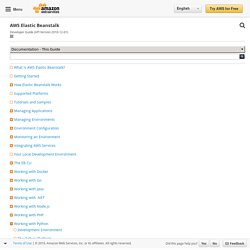
The tutorial uses the EB CLI as a deployment mechanism, but you can also use the AWS Management Console to deploy a ZIP file containing your project's contents. The EB CLI is an interactive command line interface written in Python that uses the Python SDK for AWS (boto). To use any Amazon Web Service (AWS), including Elastic Beanstalk, you need to have an AWS account and credentials. To learn more and to sign up, visit To follow this tutorial, you should have all of the Common Prerequisites for Python installed, including the following packages: Python 2.7pipvirtualenvawsebcli The Flask framework will be installed as part of the tutorial. Note. Common Steps for Deploying Python Applications - Elastic Beanstalk. AWS Elastic Beanstalk provides a consistent interface for deploying Python applications, so there are common procedures to follow regardless of the application framework you're using, or whether you're using one at all.
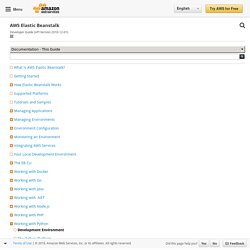
Important To use any Amazon Web Service (AWS), including Elastic Beanstalk, you need to have an AWS account and credentials. To learn more and to sign up, visit. Create an iPython HTML Notebook on Amazon's AWS Free Tier from scratch. What Roll your own iPython Notebook server with Amazon Web Services (EC2) using their Free Tier.
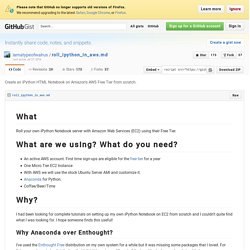
What are we using? 28.3. venv — Creation of virtual environments — Python 3.6.0a3 documentation. The venv module provides support for creating lightweight “virtual environments” with their own site directories, optionally isolated from system site directories.
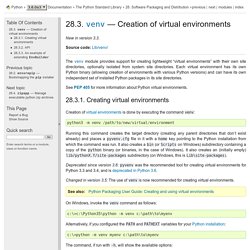
Each virtual environment has its own Python binary (allowing creation of environments with various Python versions) and can have its own independent set of installed Python packages in its site directories. Creation of virtual environments is done by executing the command venv: python3 -m venv /path/to/new/virtual/environment Running this command creates the target directory (creating any parent directories that don’t exist already) and places a pyvenv.cfg file in it with a home key pointing to the Python installation from which the command was run. It also creates a bin (or Scripts on Windows) subdirectory containing a copy of the python binary (or binaries, in the case of Windows).
Changed in version 3.5: The use of venv is now recommended for creating virtual environments. On Windows, invoke the venv command as follows: Note. Using virtualenv — Astropy v1.2.1. Virtualenv is a tool for creating and activating isolated Python environments that allow installing and experimenting with Python packages without disrupting your production Python environment.
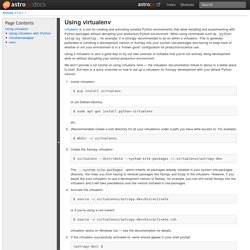
When using commands such as python setup.py develop, for example, it is strongly recommended to do so within a virtualenv. This is generally preferable to installing a development version of Astropy into your system site-packages and having to keep track of whether or not your environment is in a “known good” configuration for production/science use. Using a virtualenv is also a good way to try out new versions of software that you’re not actively doing development work on without disrupting your normal production environment. We won’t provide a full tutorial on using virtualenv here — the virtualenv documentation linked to above is a better place to start. Python virtual environments — Astropy v1.2.1.
If you plan to do regular work on astropy you should do your development in a python virtual environment.
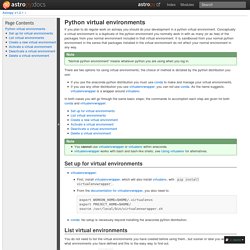
Conceptually a virtual environment is a duplicate of the python environment you normally work in with as many (or as few) of the packages from your normal environment included in that virtual environment. It is sandboxed from your normal python environment in the sense that packages installed in the virtual environment do not affect your normal environment in any way. Note “Normal python environment” means whatever python you are using when you log in. There are two options for using virtual environments; the choice of method is dictated by the python distribution you use:
Using virtualenv — Astropy v1.2.1.